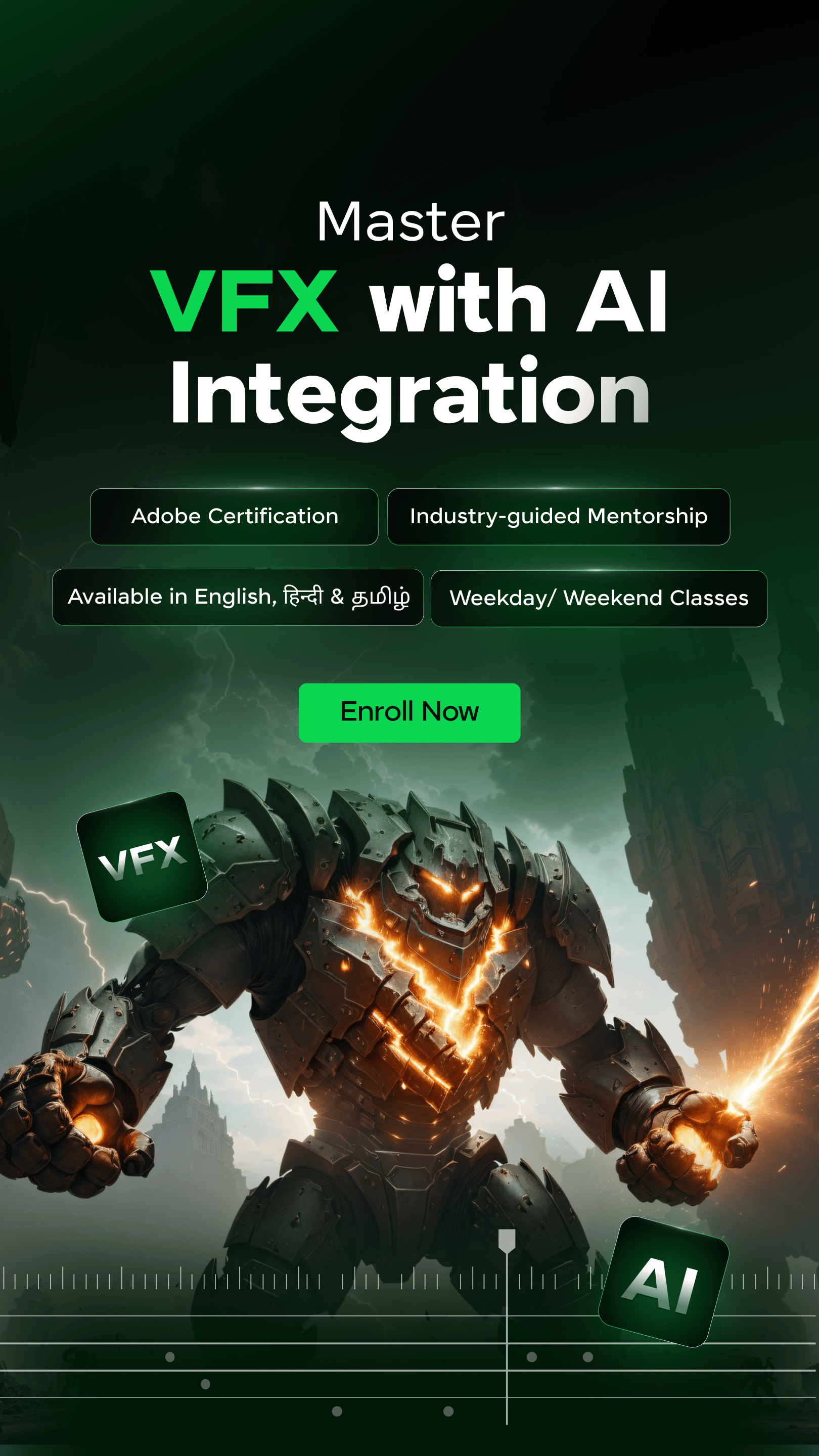
Motion Graphics Syllabus for Beginners
Apr 12, 2025 4 Min Read 4760 Views
(Last Updated)
Visual content is at the forefront, and motion graphics have become a powerful way to express your creativity. This art form blends design, animation, and storytelling to create captivating experiences that grab attention across different platforms and industries.
As the demand for impressive visual content continues to rise, becoming skilled in motion graphics gives you a chance to unleash your creativity and access well-paying job opportunities in various fields.
Whether you’re into DIY learning or signing up for a course, a motion graphics syllabus gives you a sneak peek into everything you’ll be learning. However, the most effective approach is to start from the fundamentals and progressively delve into more advanced aspects of design and animation.
Table of contents
- Complete Motion Graphics Syllabus for Beginners
- Module 1: Grasping Design Elements
- Module 2: Fundamentals of Motion Graphics
- Module 3: Graphics in Detail: Raster vs. Vector
- Module 4: Layer Choreography and Animation
- Module 5: Dimensional Depth and Effects
- Module 6: Animation and Layer Effects
- Module 7: Rendering and Media Encoding
- Module 8: Visualizing Design Fundamentals
- Module 9: Applying Design Principles in Motion
- Conclusion
- Frequently asked questions
- Is VFX part of motion graphics?
- Is drawing necessary for motion graphics?
- Should you learn graphic design before motion graphics?
- Can you teach yourself motion graphics?
- How much time does it take to learn motion graphics?
Complete Motion Graphics Syllabus for Beginners

There are nine modules in the motion graphics syllabus you’ll need to master to really understand the science behind it all and become a motion graphics designer. Each of these modules is designed to help you get better and better at the craft, focusing on understanding the design elements that go into creating compelling and resonant visual designs.
Before we proceed further, it’s essential to have a solid foundation in graphic design principles and animation basics. If you’re eager to dive deep into creating captivating motion visuals, consider joining GUVI’s Adobe Certified VFX Career Program with AI Integration. In this program, you’ll learn the fundamentals of animation, visual effects, and storytelling techniques. Gain hands-on experience with industry-standard tools and techniques, and unlock your creativity to craft stunning motion graphics for videos, presentations, and more.
Let’s explore each of these modules and what you will learn.
Module 1: Grasping Design Elements
You begin by learning the core principles of motion graphics design. These foundational design elements help you understand what it takes to create visually impactful and emotionally resonant compositions.
- Explore Typography, the language of fonts: Understand the importance of typography, the nuances of different fonts, and how they influence design and emotion.
- Dive into Color Theory and its storytelling role: Study how colors interact, evoke emotions, and play a vital role in conveying messages in design.
- Master Layout Principles for Effective Communication: Learn to harmonize visual elements and direct viewers’ attention effectively.
- Understand Information Hierarchy strategies: Discover methods to prioritize and present information clearly and logically.
- Create a Visual Hierarchy for impactful designs: Establish ways to guide viewers through a design using size, contrast, and placement.
Module 2: Fundamentals of Motion Graphics

This module is critical in this motion graphics syllabus. It provides the fundamentals necessary for you to become a motion graphics designer. You will create stunning designs with the knowledge and tools you will gain from this module.
- Introduction to VFX Software and its significance: Explore the world of visual effects software, its applications, and its relevance in creating dynamic content.
- Comparison of Node-based and Layer-based Compositing: Understand the difference between these systems and when to apply each.
- Learn the benefits of Visual Effects (VFX): Discover the potential of VFX in enhancing storytelling and creating captivating visual experiences.
- Decode File Formats for optimal usage: Grasp the different file formats, their characteristics, and best use cases.
- Get started with After Effects: Delve into Adobe’s motion graphics software, learning the basics and its application.
- Manage Assets and Composition Settings: Understand the organization, manipulation, and settings essential for effective motion design work.
Module 3: Graphics in Detail: Raster vs. Vector
Understanding the difference between Raster and Vector images is crucial for effective image manipulation and optimization in motion graphics projects. With this knowledge, you will ensure high-quality visuals that enhance the overall impact of your project.
- Navigate Digital Images and Pixel intricacies: Understand the advantages of raster and vector images.
- Learn about Color Systems and Coding: Grasp RGB, CMYK, and other color systems and their application in different mediums.
- Unveil Image Editing Tools and Techniques: Explore tools and techniques for enhancing and manipulating images to fit your design needs.
Module 4: Layer Choreography and Animation

Layer choreography and animation have immense significance within the motion graphics syllabus. You will gain a wide range of skills enabling you to animate and artistically orchestrate complex motion graphics scenes, taking your creations to the next level regarding visual impact and storytelling ability.
- Master Layer Management and Properties: Learn how to organize, adjust, and interact with layers for optimal workflow.
- Dive into Animation using Keyframes and Graph Editors: Understand the essence of animating properties over time and refining animations with graph editors.
- Enhance Compositions with Blending Modes: Discover how different layers interact and blend using various modes to create unique effects.
- Understand Mask Creation and Application: Grasp how to hide or reveal portions of a layer using masks.
- Explore Track Mattes and Luma/Alpha Channels: Dive into advanced techniques of defining visibility and layer interaction.
Module 5: Dimensional Depth and Effects
Creating depth and dimension within your motion graphics makes them feel more lifelike and immersive. You will learn the techniques of 3D layering and lighting manipulation to enrich your visuals for your viewers with a heightened sense of realism.
- Introduction to 3D Layers and Z Space: Learn the basics of 3D in motion graphics, including depth and spatial relationships.
- Manipulate Camera Settings and Lighting: Understand how cameras and lights influence a 3D space and its visual output.
- Experiment with Multiplane Compositing: Dive into the technique of layering 2D images in 3D space for a sense of depth.
Module 6: Animation and Layer Effects
Understanding the impact of layer speed on depth perception is critical, as it makes a massive difference in your work’s overall look and feel.
In this module of the motion graphics syllabus, you will master layer effects and camera movements in 3D space to add much-needed sophistication.
- Grasp Camera Movements in 3D Space: Understand the dynamics and principles of moving a camera within a 3D environment.
- Understand Layer Speed for Depth Perception: Explore how varying speeds of layers affect perceived depth.
- Explore Layer Effects, Z Channels, and RGBA Z Images: Dive into advanced layer effects and the intricacies of depth channels.
Module 7: Rendering and Media Encoding
Rendering and media encoding skills are paramount when creating motion graphics. You will get familiar with Adobe Media Encoder and learn how to render to ensure your motion graphics are polished, optimized, and ready for seamless sharing.
- Demystify Rendering with the Render Queue Panel: Grasp the process of converting compositions into playable media.
- Configure Output Settings for Rendered Content: Learn how to adjust settings for optimal playback, size, and quality.
- Introduction to Adobe Media Encoder: Explore Adobe’s media encoding software, features, and role in the post-production pipeline.
Module 8: Visualizing Design Fundamentals
One-upping your perceptive skills, you will learn the foundational elements of visual arts and design. You will get into the processes behind design ideation and execution.
- Delve into Visual Thinking and Design Process: Understand the mental processes behind design ideation and execution.
- Explore the World of Visual Arts and Design: Survey a broad spectrum of visual art forms and their influence on design.
- Understand the Elements and Principles of Design: Grasp the foundational elements (like lines, shapes, etc.) and principles (like balance, contrast, etc.) that underpin all visual designs.
Module 9: Applying Design Principles in Motion

In this final module of the motion graphics syllabus, you will get into the implementation part of translating design principles into motion graphics while learning more about animation principles and techniques.
- Translate Design Principles into Motion Graphics: Learn to apply static design principles in the dynamic realm of motion.
- Learn about Animation Principles and Techniques: Understand the principles (e.g., squash and stretch, anticipation) that give life to animations.
- Discover the Harmony between Design and Motion: Realize the symbiotic relationship between good design and fluid motion, enhancing the overall visual experience.
Conclusion
The dominating areas in the motion graphics syllabus include mastering design and animation skills, which enable you to communicate rough ideas into compelling designs that engage the audience.
Given the high online video content consumption comprising tutorial, educational, product, and gaming videos, the need for skilled motion graphics designers is hot, making this an excellent career path if you are willing to tell compelling narratives behind the camera.
Enroll in GUVI’s Adobe Certified VFX Career Program with AI Integration to get your career off to a great start. Here, you will work on amazing real-world projects while learning how to use Adobe Illustrator, Photoshop, After Effects, and Premiere Pro.
Frequently asked questions
VFX (Visual Effects) is often a component in the motion graphics syllabus. Both fields involve creating visual elements that enhance video content. While motion graphics focus on conveying messages through animated graphics and text, VFX often deals with more complex visual enhancements like CGI, simulations, and realistic effects.
Drawing skills are beneficial in motion graphics but are optional. While some motion graphics projects might involve creating original illustrations, many can be accomplished using existing assets, text, shapes, and animation techniques.
Learning graphic design before motion graphics can be advantageous, as graphic design forms the foundation of visual communication. However, it’s not mandatory. You can learn motion graphics independently and develop graphic design skills concurrently as you work on motion projects.
Yes, you can teach yourself motion graphics. Many online resources, tutorials, courses, and software allow you to learn at your own pace. Dedication, practice, and a willingness to experiment are crucial.
The time required to learn motion graphics varies on factors such as prior experience, the complexity of projects, and the depth of knowledge you want to acquire. Basic proficiency might take a few months of consistent learning and practice while becoming an expert could take a year or more of dedicated study and practical application.
















![8 Best Books to Learn Motion Graphics Design [Must-Reads] 10 Feature image - Best Books to Learn Motion Graphics Design](https://www.guvi.in/blog/wp-content/uploads/2023/10/Feature-image-Best-Books-to-Learn-Motion-Graphics-Design.webp)


Did you enjoy this article?